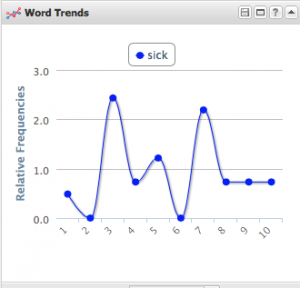In this post I will examine distant reading. Distant reading definitely has its benefits, but can it help to prove or refute a hypothesis? I am wondering whether coming about halfway through the text if James illustrates a profound shift in perception, and did he demonstrate a loss of innocence? I am going to use Voyant tools, a website which allows for analysis through distant reading, to see if I can gather some evidence to answer this question.

When I inserted the diary of Linn into Voyant tools, a word cloud appears with words that are used commonly throughout this text. I scanned this word cloud in search for words that would relate to my question. The first word that stuck out to me was sick. I figured that an increase in people getting sick might change James’s perception and also might cause him to lose his innocence, which is why I chose to analyze sick as my first word. According to the word trend, Linn did not write often about sickness in t he very beginning. However, there are two huge peaks. If there was one peak in the center of this plot, then that would give pretty good evidence to support my hypothesis. Unfortunately this is not the case and the decrease that occurs in between the two peaks provides me with confusing data. Why was there a sudden decrease before Linn picked back up and starting writing more frequently again about sickness? Although I have a few questions about the data, it does show me that from the beginning to the end there is definitely an increase in Linn’s writing of illness. This increase might have been a factor that caused Linn’s perception to shift, however we cannot know for sure.
he very beginning. However, there are two huge peaks. If there was one peak in the center of this plot, then that would give pretty good evidence to support my hypothesis. Unfortunately this is not the case and the decrease that occurs in between the two peaks provides me with confusing data. Why was there a sudden decrease before Linn picked back up and starting writing more frequently again about sickness? Although I have a few questions about the data, it does show me that from the beginning to the end there is definitely an increase in Linn’s writing of illness. This increase might have been a factor that caused Linn’s perception to shift, however we cannot know for sure.
The second word I decided to take a closer look at was battle. I tried to get in the head of Linn and I decided that if I were him, battle would definitely be something that would alter my perception and take away my innocence. The word trend shows me that at the very beginning,  battle was hardly ever written about. There was a slow increase, followed by a huge peak. The peak appears roughly halfway through the entry which would support my hypothesis. Battle became a huge part of Linn’s writing at this point and stayed important to him throughout the rest of the time he was there. It seems that once Linn began to focus on battle, he could not stop writing about it. This trend provides me with pretty good evidence that something changed about halfway through his journals, and he had a shift in the material that he chose to write about. Both of these words have similar frequencies, sick appearing 35 times, and battle appearing 38 times. The word trend of both sick and battle shows me that both of these things became more and more prominent in his life, which illustrates a change. Although this prominence is not enough to prove my hypothesis, it does support it.
battle was hardly ever written about. There was a slow increase, followed by a huge peak. The peak appears roughly halfway through the entry which would support my hypothesis. Battle became a huge part of Linn’s writing at this point and stayed important to him throughout the rest of the time he was there. It seems that once Linn began to focus on battle, he could not stop writing about it. This trend provides me with pretty good evidence that something changed about halfway through his journals, and he had a shift in the material that he chose to write about. Both of these words have similar frequencies, sick appearing 35 times, and battle appearing 38 times. The word trend of both sick and battle shows me that both of these things became more and more prominent in his life, which illustrates a change. Although this prominence is not enough to prove my hypothesis, it does support it.
This exercise taught me how helpful distant reading can truly be. If I were using close reading this task would have definitely been much harder and more time consuming. I would have had to read through the whole text and pay close attention to a shift in attitude. It would have been nearly impossible to track certain words such as battle and sick while doing a close reading. The word trends were extremely helpful in analyzing the text, as they show the frequency of specific words, I can easily see important shifts. This exercise truly opened up my eyes and I have a new appreciation for distant reading as a means of analysis.


